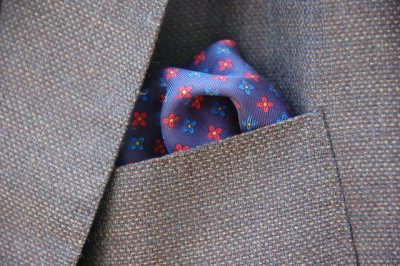Do you wear a suit and tie?
Want to set yourself apart from the crowd in a good way?
A pocket square will do that.
It has a history of class and character
has a history of class and character
In the early 1900s, a suit without a pocket square was considered almost naked.
Today it is still a key accessory for a true gentleman. Wearing a pocket square adds a hint of personality to a suit.
Although it’s a simple accessory, it effortlessly adds character to suit jackets and blazers.
Nowadays, the pocket square is becoming a sartorial signature for a new generation of men.
And it says a lot about your personality.
Pocket squares come in a variety of colors and patterns.
A pocket square is appropriate for most outfits. It should should be chosen to contrast with the shirt and tie while still being set off against the color of the jacket.
Coordinated Contrast
A coordinated contrast is a combination of pattern and fabric that is different than the suit, shirt, and tie, but not so unlike as to clash.
 Types of Pocket Squares
Types of Pocket Squares
Solid White Handkerchiefs – Linen and Cotton
The classic dress handkerchief is the solid white square, made of linen or cotton.
Depending on the chosen fold, it may be lightly starched to provide body.
The white square is acceptable for almost any ensemble but looks particularly good with dark, conservative suits where its crisp clean appearance makes it stand out in a positive way.
Silk Handkerchiefs
Silk squares are what a gentleman is most likely to encounter in department store. There are usually dozens on display.
These handkerchiefs come in nearly every color and pattern imaginable, and offer far more opportunity to make a bold and distinctive statement.
Because there are so many colors and patterns to choose from, these are the handkerchiefs that produce much of the stress associated with wearing a square.
Quality:
A hand-rolled edge is a sign of quality and attention to detail and should be present on a well-made square.
How to Match a square to your jacket and tie
When selecting the type of fabric for a dress handkerchief, the fabric of the jacket and tie should be considered. Mix silk squares with heavier tie fabrics, and more textured handkerchiefs with smooth ties. This is an excellent way to add contrast, while silk squares against a rough jacket like tweed is particularly distinctive.
Wool suits, the most common option, are equally at home with linen or silk, as are silk ties – indeed, the variety of patterns available in silk may require a silk square for some ensembles.
 How to choose patterns
How to choose patterns
Look to the most brightly colored or patterned item in the outfit. In most cases, this will be the necktie.
With solid ensembles, patterns are particularly distinctive, and while solid squares may seem a safer choice for patterned ties, a contrasting patterned square provides a very elegant look.
Handkerchief Color
As for color, it’s best to determine the base color for whatever item is being matched then opt for a complimenting color. It is best not to match the square directly to a prominent color. Instead, match it to a secondary color as an accent.
As with everything else in classic style, the choice of color should take into account the occasion you are wearing if for.
For example, though it is only a few inches of visible material, a boldly colored square would probably be out of place at a funeral or wedding.
